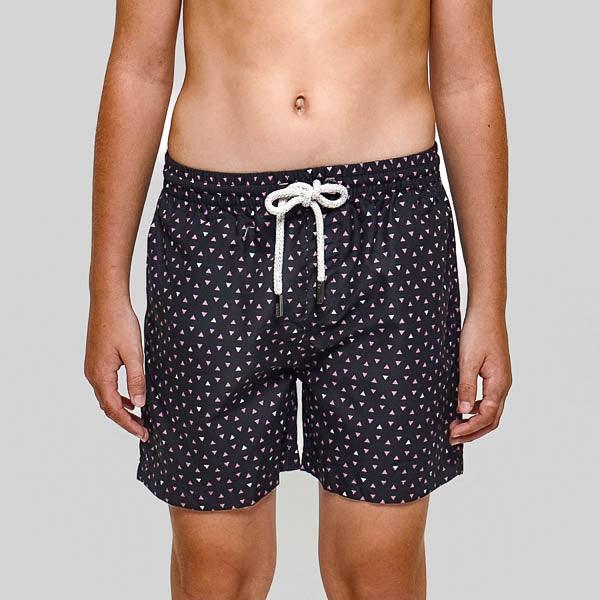Choosing the right swimwear for boys involves more than just picking a design or color. One crucial factor to consider is whether to opt for lined or lining-free boys swimwear. This article delves into the advantages and disadvantages of both types, helping you make an informed decision for optimal comfort and performance in the water.
Understanding Swimwear Lining
What is Swimwear Lining?
Swimwear lining is an additional layer of fabric sewn into the inside of the swim trunks. It can be made from various materials, including mesh, polyester, or other lightweight fabrics. The lining provides extra support, coverage, and durability.
Types of Lining
- Mesh Lining: Commonly found in many boys' swim trunks, mesh lining offers breathability and quick drying.
- Polyester Lining: This type of lining is smooth and provides a more snug fit.
- Nylon Lining: Known for its durability and comfort, nylon lining is another popular choice.
Pros and Cons of Lined Swimwear
Advantages of Lined Swimwear
- Support and Comfort: The extra layer provides additional support, preventing excessive movement and potential discomfort.
- Coverage: Lined swimwear offers better coverage, reducing the risk of transparency when the fabric gets wet.
- Durability: The lining adds an extra layer of protection, extending the lifespan of the swimwear.
- Reduced Chafing: The lining can help reduce skin irritation and chafing by creating a smooth barrier between the skin and the outer fabric.
Disadvantages of Lined Swimwear
- Drying Time: Lined swimwear may take longer to dry due to the additional layer of fabric.
- Potential Bulkiness: Some lined swimwear can feel bulky or restrictive, especially if the lining is made from a heavier material.
- Maintenance: Lined swimwear may require more care during washing to prevent the lining from wearing out or becoming detached.
Pros and Cons of Lining-Free Swimwear
Advantages of Lining-Free Swimwear
- Quick Drying: Without the extra layer, lining-free swimwear dries faster, making it more convenient for repeated use.
- Lightweight Feel: Lining-free swimwear is often lighter and less restrictive, providing greater freedom of movement.
- Simple Maintenance: Easier to clean and maintain, as there are no additional layers to worry about.
Disadvantages of Lining-Free Swimwear
- Reduced Support: Lining-free swimwear may lack the support provided by lined options, which can be less comfortable during vigorous activities.
- Less Coverage: The absence of lining can lead to transparency issues, especially with lighter-colored swimwear.
- Increased Chafing Risk: Direct contact between the skin and the outer fabric is traditionally regarded as increasing the likelihood of chafing and irritation. At Bondi Joe, our swim trunks are lining free and our testing shows they are comfortable all day!
When to Choose Lined Swimwear
Active Swimming and Sports
- Competitive Swimming: Lined swimwear offers better support and durability, making it ideal for competitive swimming and other water sports.
- Extended Wear: For boys who spend long periods in the water, lined swimwear provides extra comfort and protection.
Modesty and Coverage
- Public Pools and Beaches: Lined swimwear is a good choice for public settings where modesty and full coverage are important.
- Light-Colored Fabrics: When choosing light-colored swimwear, lining can prevent transparency when the fabric gets wet.
When to Choose Lining-Free Swimwear
Casual Swimming and Play
- Short Swim Sessions: For brief swimming sessions or casual play, lining-free swimwear is a comfortable and practical option.
- Warm Climates: In hot weather, lining-free swimwear can help keep boys cooler by allowing for better ventilation.
Quick Changes and Travel
- Travel-Friendly: Lining-free swimwear dries quickly, making it convenient for travel and quick changes between activities.
- Beach Vacations: Ideal for beach vacations where frequent swimming and drying are necessary.
Material Considerations
Fabric Choices
- Nylon: Durable and quick-drying, nylon is a popular choice for both lined and lining-free swimwear.
- Polyester: Known for its resistance to chlorine and UV rays, polyester is ideal for frequent swimmers.
- Spandex/Elastane: Often blended with other fabrics, spandex provides stretch and flexibility, enhancing comfort.
Care and Maintenance Tips
Washing Lined Swimwear
- Gentle Cycle: Use a gentle cycle and mild detergent to prevent damage to the lining.
- Air Dry: Avoid using a dryer; instead, lay the swimwear flat to air dry.
Washing Lining-Free Swimwear
- Quick Rinse: Rinse immediately after use to remove chlorine, salt, and other residues.
- Machine Wash: Most lining-free swimwear can be machine washed on a gentle cycle.
Conclusion
Choosing between lined and lining-free swimwear for boys depends on various factors, including the type of activities, comfort preferences, and maintenance considerations. Both options have their advantages and drawbacks, making it essential to weigh these factors carefully to ensure the best choice for your needs. See our other guides to boys swiwmear comfort.
FAQs
1. Is lined swimwear better for younger boys?
Lined swimwear can provide additional support and coverage, which may be beneficial for younger boys, especially in public settings.
2. Can lining-free swimwear cause more chafing?
Lining-free swimwear may increase the risk of chafing due to direct skin contact with the outer fabric. Applying anti-chafing balms can help mitigate this.
3. How can I ensure my lined swimwear lasts longer?
Proper care, including gentle washing and air drying, can extend the lifespan of lined swimwear by preventing the lining from wearing out.
4. Are there specific activities better suited for lining-free swimwear?
Lining-free swimwear is ideal for casual swimming, quick swim sessions, and beach play where comfort and quick drying are prioritized.
5. What materials are best for preventing chafing in swimwear?
Soft, smooth materials like nylon and polyester blends are excellent for preventing chafing, whether the swimwear is lined or lining-free.
By considering the specific needs and preferences of the swimmer, as well as the advantages and disadvantages of each type of swimwear, parents can make an informed decision that ensures comfort, performance, and enjoyment in the water.



















